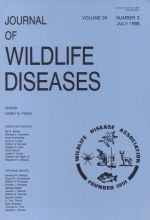Ivermectin was injected subcutaneously at 200 and 400 μg/kg of body weight into seven white-tailed deer (Odocoileus virginianus) in an attempt to control the muscle nematode Parelaphostrongylus andersoni. Counts of first-stage larvae in feces dropped to zero at 17 to 18 days posttreatment. Larvae reappeared in feces 1.5 to 6 wk later in six deer. Four deer were treated again approximately 9 wk after the first treatment; larval counts dropped to zero in 12 to 18 days. Larvae reappeared in low numbers 45 to 55 days after the second treatment. Because deer were held indoors on cement and the prepatent period of these worms is approximately 2 mo, the reappearance of larvae was not due to reinfection by accidental ingestion of gastropod intermediate hosts. Results suggest that ivermectin at dosages of 200 or 400 μg/kg of body weight suppressed larval production by adult female nematodes for several weeks or destroyed first-stage larvae in the lungs.
How to translate text using browser tools
1 July 1988
EFFICACY OF IVERMECTIN AGAINST PARELAPHOSTRONGYLUS ANDERSONI (NEMATODA, METASTRONGYLOIDEA) IN WHITE-TAILED DEER (ODOCOILEUS VIRGINIANUS)
W. M. Samuel,
J. Brent Gray

Journal of Wildlife Diseases
Vol. 24 • No. 3
July 1988
Vol. 24 • No. 3
July 1988
experimental study
Ivermectin
muscle nematodes
Odocoileus virginianus
Parelaphostrongylus andersoni
white-tailed deer




